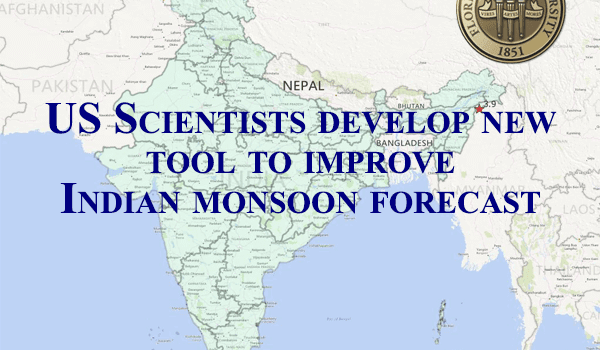
The researchers from Florida State University (FSU) have developed a new tool for objectively defining the onset and demise of the Indian Summer Monsoon (ISM), which affects millions of people annually. This study is based on more than 100 years of the Indian Meteorological Department (IMD)’s rainfall analysis.
They outline a methodology that uses rainfall rates to mark the span of the Indian Summer Monsoon (ISM) at any given location throughout the affected region.

Check India’s official weather forecasts and weather on INSAT Satellite Animation .
Current method to monitor Indian monsoon
Dr. Vasubandhu Misra, associate professor at the Florida State university, stated that:
At present, current weather forecasting and monitoring protocols focus attention on monsoon onset at one location – specifically the State of Kerala – and predict future outcomes based on those facts & figures for the rest of the region.
Dr. Misra further said:
In some parts of the country, the torrents of rain that characterize monsoon season account for more than 90% of the total annual precipitation.
As a result, many rhythms of Indian political and agricultural life can be destabilized by dubious or false claims of monsoon onset. That leads to tremendous amounts of frustration and confusion for the general public and for the people who are trying to monitor the monsoon because nobody has really gotten down to do it at a granular scale.
Till date, the lack of a clear, granular and objective benchmark for monsoon onset and demise for all areas of the country has been a longtime source of anxiety for the Indian people, according to researchers.
Northeast Monsoon rains has commenced over Tamilndau & adjoining areas today onwards.
Blo r Inf n Warning for today 27th October, 2017. pic.twitter.com/OTS1k7Shdp— India Met. Dept. (@Indiametdept) October 27, 2017
New method to forecast Indian monsoon
Regarding to new definition of Indian monsoon forecast, Dr. Misra stated that:
We have gone down to specific locations, we have covered the whole country, and we have objectively defined the onset and demise dates for any given year. With this methodology, a question that has puzzled meteorologists for decades finally can have a simple, actionable answer.
READ MORE Indian scientists developed Artificial leaf to create hydrogen fuel from sunlight
New methodology: Real-time monitoring
According to the researchers, this new methodology ties the onset of the monsoon to location-specific rainfall thresholds & can work to ease that frustration.
This new method will allow officials and researchers throughout the country to define the Indian monsoon season using a standardized system that, through rigorous testing, has been shown to capture ISM evolution comprehensively.
Up until now, regional meteorological departments have relied on their own ad hoc criteria for determining ISM onset, which can often lead to contradicting claims.
As per study, anchoring the definition of onset and demise solely in local rain rates eliminates the need to rely on less accessible atmospheric variables. This streamlined approach makes it considerably easier to monitor monsoon evolution.
Dr. Misra said:
Their research enables quite easy real-time monitoring of the onset and demise of the Indian monsoon.
He further stated that you don’t need complicated definitions on rainfall. They have tested this for 105 years of available data, and this criterion has not failed once for any location over India.
The recent study is published in the journal Climate Dynamics .






